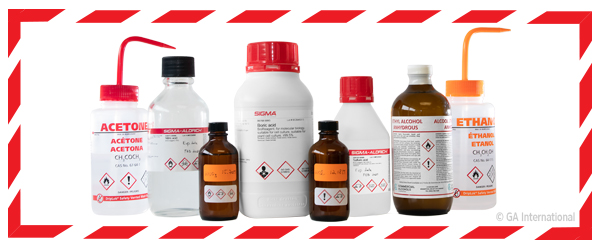
Labeling hazardous chemicals under GHS?
Because of the large scale of global trade, the safety data regarding each chemical must be followed by teams of experts who can properly assess potential hazards. Thus, having one system—with only one kind of container label and safety data sheet (SDS)—makes the transportation of chemicals a safer, more regulated process. The GHS also makes chemical transportation more cost-effective by reducing the need to evaluate the chemical against many different classification systems.1
So, what’s required on a GHS label? There are 6 criteria that must be included, all of which should appear together on the label:2
Signal word – A word to describe the level of severity of the hazard, such as “Warning” or “Danger.” Chemicals with the signal word “Danger” are considered more severe health risks than those which are labeled with “Warning.”
Hazard statement – A phrase that assigns a class and category, describing the nature and degree of the hazard.
Precautionary statement – Precautionary statements should be included to advise on how to minimize or prevent the adverse effects of exposure as well as improper storage or handling of the chemical.
Pictogram – Pre-designed pictograms should be included that give brief, detailed information on the nature of the risks posed by the chemical.
Product identifier – The identity of the chemical should be inscribed on the label. For a mixture, the names of all chemicals that pose a health risk should be indicated. All product identifiers should match the corresponding SDS document.
Supplier identification – The name, address, and telephone number of the supplier or manufacturer should also be specified.
Not all countries have adopted GHS requirements in the same way. In 2012, the United States integrated GHS into several of its chemical regulatory departments, most notably the Occupational Safety and Health Administration (OSHA). Their Hazard Communication Standard (HCS) was amended to focus on the principles of GHS, with chemical classifications based on the global system. Other major revisions to the OSHA guidelines include a new SDS format, modifications to several definitions and terms, and training requirements for employees.3
Canada has also integrated GHS principles into its current Workplace Hazardous Materials Information System (WHMIS). The WHMIS was recently overhauled to include GHS-specific requirements in three phases, culminating in the requirement for all employers to be compliant with Canada’s updated Hazardous Products Regulation (HPR) by December 1, 2018. Like the HCS, the updated HPR will introduce the global SDS format and chemical classifications.4
Labels that meet GHS requirements
Employing proper labels for containers harboring hazards is important, no matter where you work. Labels that fall off or become illegible pose a significant health risk as users might mistake the unlabeled bottle for another chemical or may dispose of the contents in a way that threatens their safety. To ensure that GHS labels remain affixed to their containers, the label’s adhesive should be resistant to the chemical contained in the bottle as well as other compounds, like water and ethanol, that the labels might encounter on an everyday basis. Thermal-transfer printing using a resin ribbon affords the most resistance against smudging or fading due to chemical exposure; however, for labels that are printed on using digital methods (inkjet or laser), adding varnish or a laminate may provide some additional protection. Pre-printed GHS labels are also an option and can be laminated to prevent the label from failing when exposed to hazards.
Whether you work in a lab or a pharmaceutical company, it’s important for all employers to follow the regulations outlined in the GHS, in one form or another. Using the right labels to catalog hazardous chemicals with all pertinent information is necessary to prevent mishaps and potentially perilous situations, making it easier to safeguard your health and safety as you work.
LabTAG by GA International is a leading manufacturer of high-performance specialty labels and a supplier of identification solutions used in research and medical labs as well as healthcare institutions.
References:
- SCHC-OSHA Alliance. What Is the GHS? Annandale, VA; 2010.
- United Nations. Globally Harmonized System of Classification and Labelling of Chemicals (GHS): Seventh Revised Edition. New York, NY; 2017.
- OSHA. GHS – OSHA HCS Comparison: Comparison of Hazard Communication Requirements. Washington, DC; 2018.
- Government of Canada. Frequently Asked Questions: Workplace Hazardous Materials Information System (WHMIS). Ottawa, ON; 2018.